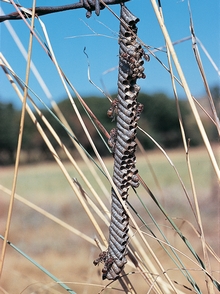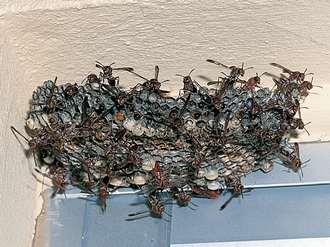Distribution
|
Worldwide.
|
Biology |
 
Social, constructing communal paper nests usually comprising a
single comb (double comb in Polybiodes), which may be arranged
vertically or horizontally. The comb is usually exposed, but in
Polybioides the comb is enclosed in a thin, brittle paper
covering. Larvae are fed
on chewed-up, soft-bodied insects such as caterpillars.
New nests are started in spring by a fertilized female who
has overwintered in a sheltered position, often together with other
mated females. She begins by constructing a strong stalk attached
to a branch within a bush, under a rock overhang, or under the eaves of
a roof. The stalk and subsequent downward hanging hexagonal cells are
made from chewed up plant fibres mixed with saliva, producing a tough
papery material that is also very light. The hexagonal cells are added
in ever increasing concentric circles away from the central stalk, which
is smeared with a dark ant-repellent secretion produced by her abdominal
glands. This prevents predatory ants from raiding the nest.
The foundress female lays an egg at
the bottom of each cell she has constructed. On hatching the larva is fed pellets of chewed
up caterpillars. Once the larva reaches maturity the cell is capped and
the larva pupates. On emerging, this first generation of new wasps, which are the foundress
female's daughters, assist with nest building and raising their
siblings. They are unable to mate as there are no males in the colony at
this stage. The ovaries of these workers do not develop and are
maintained in this condition by aggressive behaviour exerted towards
these individuals by the foundress queen. With some species the
foundress queen is joined by other mated females who also lay eggs.
Rival females eat each other's eggs until one female achieves dominance.
The worker females are responsible for hunting caterpillars
and presenting the chewed up bolus to the larvae in the cells, which then
bite off pieces. The larvae regurgitate saliva, which is consumed by the
worker female. This transfer of saliva (trophallaxis) provides the
worker with essential nutrients such as carbohydrates, proteins and
probably also enzymes, that she cannot make herself. Larvae are
occasionally given the feeding response by workers or the queen without
food presentation to solicit saliva for their own consumption. Returning
workers are also sometimes forced to give up their food provision by
females higher up the dominance hierarchy. The queen never leaves the
nest and is fed by the workers. Nest defense is achieved via very
painful stings delivered by the workers. Stings are not barbed and the
females can administer venom repeatedly.
The haplo-diploid method of sex determination in
Hymenoptera (where unfertilized eggs give rise to males and fertilized
eggs to females) means that sisters share 75% of their genes, but only
50% of their genes are shared with their daughters. Hence, a female who
helps raise her sisters (some of whom will develop into queens) and does
not lay her own eggs contributes to her own reproductive success, since
she is getting a greater proportion of her own genes into the next
generation (75% of her genes) than if she raised her own off-spring (50%
of her genes). This is the basis of Kin selection theory and is thought
to be one of the reasons why sociality has evolved so many times within
the Hymenoptera, whereas it has only evolved once in the other insects
(in the termites).
By autumn the queen has no more sperm left and lays
unfertilized eggs, which give rise to males. The colony breaks up and
the males disperse to mate with females from other colonies, after which
they die. The mated females then go into diapause to overwinter, ready
to start new colonies the following spring.
Summarized from various sources, including O'Toole, 1995;
Holm, 2008. |
References |
Benadé PC, Veldtman R, Samways MJ & Roets F. 2014.
Rapid range expansion of the invasive wasp Polistes dominula
(Hymenoptera: Vespidae: Polistinae) and first record of parasitoids on
this species and the native Polistes marginalis in the Western
Cape Province of South Africa. African Entomology 22(1): 220-225.
doi:
http://dx.doi.org/10.4001/003.022.0104
Bequaert, J.C. 1918.
A revision of the Vespidae of the Belgian Congo based on the collection of the
American Museum Congo Expedition: with a list of Ethiopian diplopterous wasps.
Bulletin of the AMNH 39: 1-384.
Brooks RW & Wahl DB. 1987. Biology and mature
larva of Hemipimpla pulchripennis (Saussure), a parasite of
Rhopalidia (Hymenoptera: Ichneumonidae, Vespidae). Journal of the
New York Entomological Society. 95: 547–552.
Brothers, D.J. &
Finnamore A.T. 1993. Superfamily Vespoidea (pp. 161-278).
In
GOULET, H. & HUBER,
J. (eds). Hymenoptera of the World: an identification guide to families.
Research Branch, Agriculture Canada, Ottawa, Canada, 668 pp.
Carpenter, J. M. & M.
Madl. 2009. A catalogue of the Vespidae of the Malagasy Subregion (Insecta,
Hymenoptera). Linzer Biologische Beiträge 41 (2): 1871-1935.
Gess, S.K. & Gess, F.W. 2014.
Wasps and bees in southern Africa. SANBI
Biodiversity Series 24. South African National Biodiversity Institute,
Pretoria. 320 pp.
Guilherme J.L. & Wit, P. 2015. First records for
Guinea-Bissau of Vitelline Masked Weaver and its nesting association with a
paper wasp. ABC Bulletin 22: 200 - 203.
Holm, E. 2008. Insectlopedia of southern Africa. LAPA publishers (Pty)
Ltd, Pretoria.
Keeping MG & Crewe RM. 1983. Parasitoids,
commensals and colony size in nests of Belonogaster (Hymenoptera:
Vespidae). Journal of the Entomological Society of Southern Africa.
46: 309–323.
O'Toole, C. 1995.
Alien Empire: an exploration of the lives of insects. BBC Books, BBC Worldwide
Limited, London.
Picker,
M., Griffiths, C & Weaving, A. 2002. Field Guide to Insects of South Africa.
Struik Publishers, Cape Town.
Polašek O, Bellingan T, van Noort S. 2022.
A new species of paper wasp from the genus Ropalidia Guérin-Méneville
from South Africa (Hymenoptera: Vespidae). Journal of Hymenoptera
Research 90: 213–222.
https://doi.org/10.3897/jhr.90.81581
Richards,
O.W. 1982. A revision of the genus
Belonogaster de Saussure (Hymenoptera: Vespidae). Bull. Brit. Mus.
Nat. Hist. Entomol 44: 31–114.
van Zyl C, Addison P, Veldtman R. 2018.
The invasive Vespidae in South Africa: potential management strategies and
current status. African Entomology 26: 267-285.
http://dx.doi.org/10.4001/003.026.0267 |
Credits
|
Photographs
© Vida van der Walt (Pretoria)
or © Marian Oliver (Cape Town) or
© Simon van Noort (Iziko Museums of South Africa), or © Mike Picker & Charles Griffiths (University of Cape Town)
or Alan Weaving (published
in Struik's
Field Guide to Insects of South Africa).
|
|